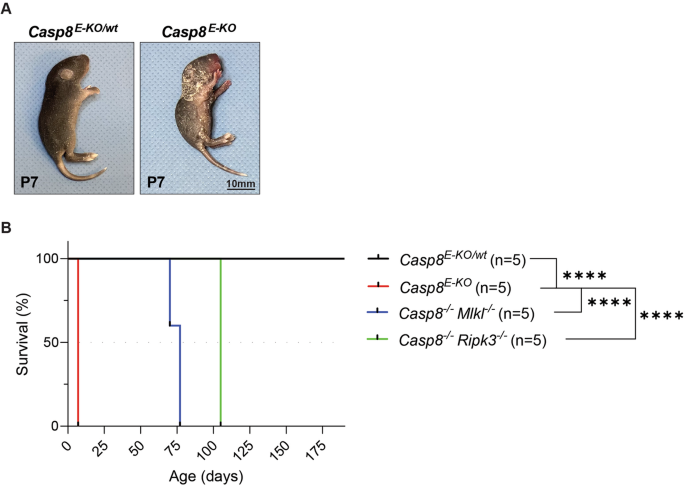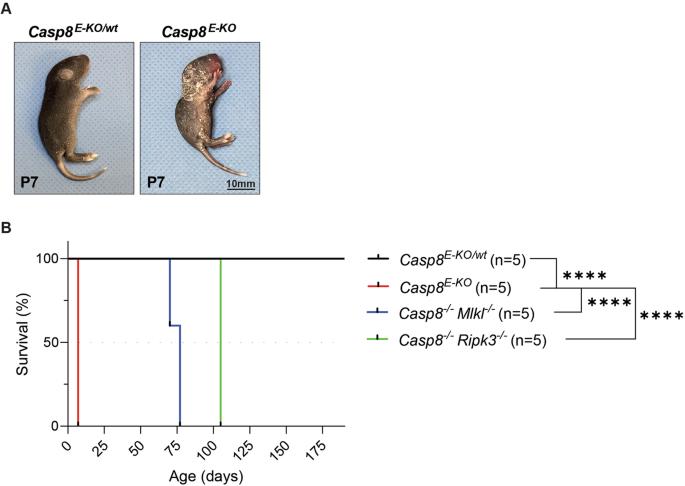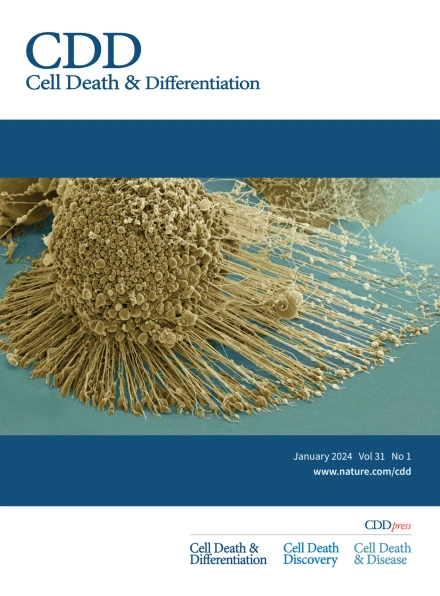小鼠磷酸化-MLKL-S345原位检测对体内坏死评估的重要性
IF 13.7
1区 生物学
Q1 BIOCHEMISTRY & MOLECULAR BIOLOGY
引用次数: 0
摘要
坏死是一种与许多炎症病理有关的、不依赖于卡巴酶的细胞死亡方式。这一途径的执行需要形成一个由 RIPK1 和 RIPK3 组成的细胞膜平台,而 RIPK3 又反过来介导伪激酶 MLKL(小鼠为 S345)的磷酸化。该刽子手被激活后,会寡聚并聚集在浆膜上,通过浆膜失稳和随之而来的通透性导致细胞死亡。虽然对这些事件的生化和细胞特征进行了大量研究,但目前对体内动物模型参与坏死凋亡的研究仅限于使用 Mlkl-/- 或 Ripk3-/- 小鼠。然而,即使在许多已从遗传学角度证明了坏死参与疾病病因学的模型中,也缺少关于哪些组织和特定细胞类型受到致病性坏死影响的基本体内特征描述。在这里,我们描述并验证了一种基于免疫组织化学和免疫荧光的方法,它能可靠地检测小鼠 MLKL 在丝氨酸 345 处的磷酸化(pMLKL-S345)。我们首先利用分别从角质形成细胞或肠上皮细胞中特异性删除了 Caspase-8(Casp8)或 FADD 的小鼠的组织对该方法进行了验证。接下来,我们证明了在 SARS-CoV 感染小鼠的肺部以及 Sharpin 失活突变小鼠的皮肤和脾脏中存在坏死激活。最后,我们排除了在 TNF 诱导的脓毒性休克小鼠肠道中发生坏死的可能性。重要的是,通过直接比较其中一些模型中 pMLKL-345 的染色与裂解 Caspase-3 的染色,我们确定了坏死和凋亡之间的时空和功能差异,支持 RIPK3 在炎症中的作用独立于 MLKL,而 RIPK3 在激活坏死中的作用独立于 MLKL。本文章由计算机程序翻译,如有差异,请以英文原文为准。


The importance of murine phospho-MLKL-S345 in situ detection for necroptosis assessment in vivo
Necroptosis is a caspase-independent modality of cell death implicated in many inflammatory pathologies. The execution of this pathway requires the formation of a cytosolic platform that comprises RIPK1 and RIPK3 which, in turn, mediates the phosphorylation of the pseudokinase MLKL (S345 in mouse). The activation of this executioner is followed by its oligomerisation and accumulation at the plasma-membrane where it leads to cell death via plasma-membrane destabilisation and consequent permeabilisation. While the biochemical and cellular characterisation of these events have been amply investigated, the study of necroptosis involvement in vivo in animal models is currently limited to the use of Mlkl−/− or Ripk3−/− mice. Yet, even in many of the models in which the involvement of necroptosis in disease aetiology has been genetically demonstrated, the fundamental in vivo characterisation regarding the question as to which tissue(s) and specific cell type(s) therein is/are affected by the pathogenic necroptotic death are missing. Here, we describe and validate an immunohistochemistry and immunofluorescence-based method to reliably detect the phosphorylation of mouse MLKL at serine 345 (pMLKL-S345). We first validate the method using tissues derived from mice in which Caspase-8 (Casp8) or FADD are specifically deleted from keratinocytes, or intestinal epithelial cells, respectively. We next demonstrate the presence of necroptotic activation in the lungs of SARS-CoV-infected mice and in the skin and spleen of mice bearing a Sharpin inactivating mutation. Finally, we exclude necroptosis occurrence in the intestines of mice subjected to TNF-induced septic shock. Importantly, by directly comparing the staining of pMLKL-345 with that of cleaved Caspase-3 staining in some of these models, we identify spatio-temporal and functional differences between necroptosis and apoptosis supporting a role of RIPK3 in inflammation independently of MLKL versus the role of RIPK3 in activation of necroptosis.
求助全文
通过发布文献求助,成功后即可免费获取论文全文。
去求助
来源期刊

Cell Death and Differentiation
生物-生化与分子生物学
CiteScore
24.70
自引率
1.60%
发文量
181
审稿时长
3 months
期刊介绍:
Mission, vision and values of Cell Death & Differentiation:
To devote itself to scientific excellence in the field of cell biology, molecular biology, and biochemistry of cell death and disease.
To provide a unified forum for scientists and clinical researchers
It is committed to the rapid publication of high quality original papers relating to these subjects, together with topical, usually solicited, reviews, meeting reports, editorial correspondence and occasional commentaries on controversial and scientifically informative issues.
 求助内容:
求助内容: 应助结果提醒方式:
应助结果提醒方式:


